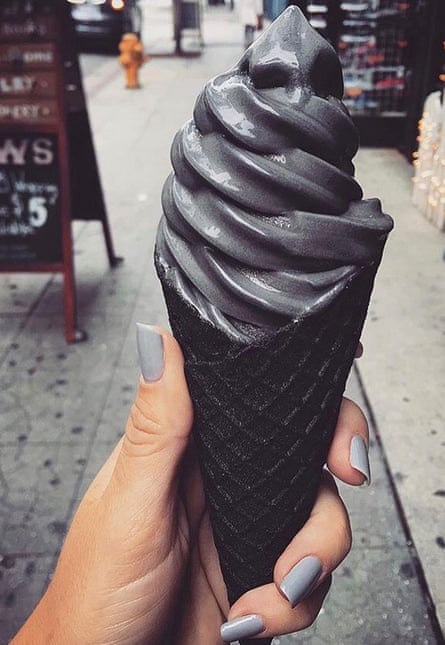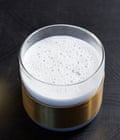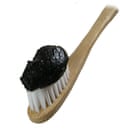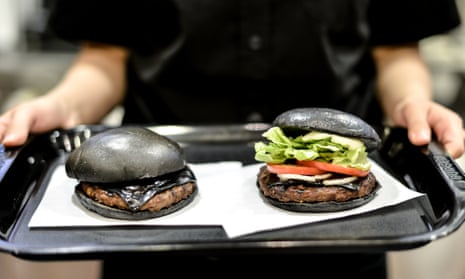There are two kinds of food that exist solely to be Instagrammed. There’s the gregarious type, prefixed by “unicorn”, striped through with bright colours and dusted with glitter. And then there is its surly cousin, which exists in simple, stark monochrome. Over the last few years, the trend for black food has been growing. Burger King was an early pioneer, offering a “kuro burger” in some of its Japanese stores in 2012, sandwiching a patty between a sliced black bun, with a sliver of black cheese, and a black sauce made from squid ink. Since then, social media-savvy food outlets have increasingly turned to the dark side. You can now get your hands on black hotdogs, black smoothies and black desserts – LA’s Little Damage ice-cream parlour caused a frenzy in press coverage with its black soft serve on a black waffle cone. Waitrose recently released a limited edition antipasti pizza made with a black sourdough base, having launched a Heston-endorsed salmon and cream cheese black bagel last year. There is one key ingredient infusing these snacks with the hue of a teenage goth’s bedroom wall: charcoal.
The Guardian’s product and service reviews are independent and are in no way influenced by any advertiser or commercial initiative. We will earn a commission from the retailer if you buy something through an affiliate link. Learn more.
“Charcoal was an ingredient we started to see emerging in restaurants and food pop-ups last year. With its earthy, slightly smoky taste and dark colouring, it gives a premium feel to food and makes it a real talking point,” says Jonathan Moore, executive chef for Waitrose. But while it may be appearing on buzzy menus and the plates of more adventurous MasterChef contestants with increasing regularity, that doesn’t mean it’s a good idea to nab a barbecue briquette from the shed and sprinkle it on your salad. Activated, food-grade charcoal is a modified form of the stuff, which means its surface area has been maximised to make it more porous. It’s popular in powdered or capsule form in many natural food stores, and is usually made from coconut shells or bamboo.

The visual impact of an all-black dish combined with that smoky umami flavour has been embraced by foodies, but charcoal has become big business in the health and beauty market, too. In early March, a YouTuber called Tiff brought charcoal face masks to the newsfeeds of the masses thanks to a video entitled “Charcoal Face Mask Gone Wrong OFFICIAL”. According to the product’s Amazon page, the mask uses activated bamboo charcoal which “acts like a magnet to draw out the most deeply-rooted impurities”. Tiff screams as she struggles to remove it from her skin. “Smoothes the skin’s texture. Wanna know why? Cos it rips it off,” she explains, wincing from all that magnetism.
Other YouTubers offer their own recipes for DIY charcoal masks, which typically involve charcoal powder and PVA glue. It doesn’t take a particularly scientific brain to figure out that it’s probably not the powder part ripping off the skin. Charcoal has also found its way into dentistry, with numerous teeth-whitening products on the market, from charcoal powders to charcoal and coconut oil. However Professor Damien Walmsley, British Dental Association scientific adviser, is sceptical about the benefits of brushing with black powder. “There isn’t the evidence to show that activated charcoal is good for your teeth. Charcoal is an abrasive substance so prolonged use could actually damage the enamel,” he says.
It is wellness advocates, though, who have jumped on the supposedly magical properties of charcoal with the most enthusiasm. Over the last few years, it has been recommended or sold by Gwyneth Paltrow’s lifestyle platform Goop for use as a face mask, soap and cleanser, as an ingredient in various drinks from chai to lemonade, and as an infusion in the bristles of a toothbrush. There are a number of juice companies selling charcoal-based drinks, including Botanic Lab, which offers an “isotonic refuel” drink with “medical grade charcoal and mighty raw cane to cleanse, reload and rebalance the body”. The Danish company Sort Of Coal, which has a glass water bottle with a stick of Kishu-brand binchotan (white charcoal, from Japan) in its online store for 645 krone (£75) states that adding a stick of charcoal to tap water turns it into mineral water via a natural purifying process.

The medicinal properties of activated charcoal have been known for a very long time. Both Hippocrates (c400BC) and Pliny the Elder (AD50) wrote about its use in treating a variety of ailments, including vertigo, anthrax and absorbing the odours from rotting wounds. In hospitals today, it may be used to treat some overdoses and instances of acute poisoning, as it can absorb certain toxins in the gut before they enter the bloodstream. Vets may prescribe it to dogs that have eaten substances that are toxic to them, like chocolate.
It’s easy to see why it has been picked up as a miracle cure. We live in an age of obsession when it comes to nutrition, health and the pursuit of “detoxing” the body, spending staggering amounts of money on alternative medicines and faddy foods, with little proof of their efficacy. “There is no nutritional composition data available for activated charcoal so it’s unknown whether it has any nutritional value,” cautions Sarah Coe, nutrition scientist for the British Nutrition Foundation.
Edzard Ernst, emeritus professor of the University of Exeter and author of Homeopathy: The Undiluted Facts, is extremely wary of its use as a health supplement. “It can indeed absorb some substances but not all, and it can only do that in the gut. This means that for detoxifying the body it is next to useless in many situations,” he says. “It absorbs things that the body needs, for instance medications, which can lead to problems, of course. Foremost, it absorbs water from the gut, which can lead to dehydration and constipation.”
Even the traditionally effusive Goop, which sells a herbal supplement called “Sex Dust” for $30 a pot, issued a warning with its recipe for an activated charcoal chai, pointing out that “recreational charcoal use comes with some serious caveats. The issue is that while charcoal can certainly usher out not-so-great stuff, it can also bind to nutrients and meds, making them difficult to absorb.”

However, there is one use for charcoal which is NHS-approved: it is recommended as a treatment for excessive flatulence. “Whilst a health claim for this benefit (1g at least 30 minutes before a meal and 1g after the meal) has been approved for use, there is no evidence to suggest that taking activated charcoal could have any other benefit to health, including a ‘detox’ effect on the body,” says Coe.
In that case, all the hype around charcoal sounds like hot air. It may look arresting on Instagram, and may taste good in a pizza base, but the idea of using charcoal in the quest for wellness appears to be a burnout. One charcoal company’s website claims that it can balance mind and body through a de-ionising process; Ernst says this is “nonsensical and misleading to the point of being dangerous”. In fact, he says, it only goes to show just how absorbent charcoal really is: “In my view, this claim is a good marketing gimmick to absorb the maximum of cash from gullible consumers.”
Morwenna Ferrier tests out six big-selling charcoal products

Charcoal crust pizza
Proof that charcoal food is just weird and pointless comes via this charcoal crust pizza topped with antipasti. It tastes fine, if a little grainy. It takes 10-15g of charcoal per half-kilo of flour to make this, meaning the charcoal content is so low that it feels a completely pointless exercise. Worst of all, I get black bits in my teeth, but no one tells me until I get home.

Smoked salmon and cream cheese charcoal bagel, by Heston Blumenthal for Waitrose
Firstly: why? Bagels were one of the first foods to be hit by charcoal mania – they were originally made with squid ink, but charcoal was substituted for the non-kosher ingredient. None of this answers the question of why – it’s dry, dull and criminally pointless. The charcoal makes the bagel look like basalt. The filling is OK though.
Charcoal facial sponge
This sponge claims to contain mineral-rich – they don’t say which minerals – charcoal, which supposedly draws out toxins while very gently exfoliating your face. Supermodels use it, too. It also expands in water, like rice, which is cool. I use it twice a day for a few weeks and my skin feels softer and smoother after each use. Finally! Something with legs.
Shills peel-off mask
The mother of charcoal beauty products, this promises to increase vitality and give me a youthful glow. I watch a few YouTube tutorials before trying it out. Most of them are warning videos – fake face masks are doing the rounds on the internet. Hope this one isn’t black glue. I try a bit on my hand and it peels off easily after 10 minutes. I try it on my chin. Having a black face starts to feel problematic, so I try to peel it off. This time it doesn’t work. I panic and scrub at the charcoal mask with the charcoal sponge. It works. Is this cannibalism, I wonder.

Bamboo charcoal toothpaste
Continued brushing with charcoal toothpaste is, say the infomercials, the fastest way to whiten teeth without bleaching them. Again, the colour – more of a slate – is a little unsettling, but it tastes fine: minty, fresh. The texture is a little granular, too. A week’s brushing produces little change – you need to do it for several – but at the end of it, my teeth aren’t yellow. They’re not black either, so that’s a result.
Charcoal coffee
I’m a little hungover and this is where charcoal comes into its own. Activated charcoal is used to prevent poisons and toxins, like alcohol, being absorbed by the body. I drop £4.50 on a charcoal iced flat white with almond milk and some sort of syrup at Palm Vaults, Hackney’s “most Instagrammable” cafe. I still feel awful, except now I’m skint too, but it does get some decent numbers on the socials.

Comments (…)
Sign in or create your Guardian account to join the discussion